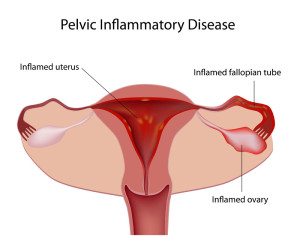Introduction
For the purpose of this review pelvic Inflammatory Disease (PID) describes an infection of the upper genital female tract. This can include any of the structures between the ovary to the cervix. That is to say, part of this are an infection of the ovary (“oophoritis”), infection of the fallopian tube (=”salpingitis”), infection of the uterus inside (=”endometritis”) and infection of the cervical canal (=”cervicitis”). In this case, the common bacteria that cause these infections belong into the venereal disease category as PID commonly transmits sexually.
First of all, on top of the causes is Neisseria gonorrhea, the bacterium responsible for gonorrhea. Another common cause is Chlamydia trachomatis.
Symptoms
PID symptoms are a fever and lower abdominal pain. Granted, there might be a vaginal discharge and some period like bleeding between periods. Also, the symptoms may involve abdominal pain, particularly when the fallopian tube or the ovary are part of the infection. This is certainly common with gonorrhea, which very quickly can destroy the normal tissue and lead to a pelvic abscess and peritonitis. Often it leaves severe scarring behind and frequently it affects both sides. Frequently, with cervicitis there is bleeding on sexual contact. Additionally, a purulent discharge is evident, particularly when the doctor examines the patient. Salpingitis starts shortly after the woman’s period with lower abdominal pain.
Examination and tests
Furthermore, when the doctor moves the cervix during the examination of the patient, there is tenderness on the side of the infection. Likewise, the clinical presentation can be very similar in symptoms to acute appendicitis and pose a diagnostic problem on the right side. Above all, if in doubt the specialist organizes a laparoscopy for diagnostic purposes. Most noteworthy, one of the lasting effects of a PID is infertility through scarring of both fallopian tubes. Therefore, the physician needs to promptly diagnose and treat the condition.
Treatment of PID
Above all, antibiotic therapy is immediately started, usually intravenously. This is carried on until the patient has been without a fever (=afebrile) for 24 hours. Then oral antibiotics are carried on for as long as the doctor orders. An abscess has to be drained by the gynecologist by one of the approaches (trans-vaginal or percutaneous) under ultrasound guidance. The sexual partner(s) of the patient should also be treated.
References
1. DM Thompson: The 46th Annual St. Paul’s Hospital CME Conference for Primary Physicians, Nov. 14-17, 2000, Vancouver/B.C./Canada
2. C Ritenbaugh Curr Oncol Rep 2000 May 2(3): 225-233.
3. PA Totten et al. J Infect Dis 2001 Jan 183(2): 269-276.
4. M Ohkawa et al. Br J Urol 1993 Dec 72(6):918-921.
5. Textbook of Primary Care Medicine, 3rd ed., Copyright © 2001 Mosby, Inc., pages 976-983: “Chapter 107 – Acute Abdomen and Common Surgical Abdominal Problems”.
6. Marx: Rosen’s Emergency Medicine: Concepts and Clinical Practice, 5th ed., Copyright © 2002 Mosby, Inc. , p. 185:”Abdominal pain”.
7. Feldman: Sleisenger & Fordtran’s Gastrointestinal and Liver Disease, 7th ed., Copyright © 2002 Elsevier, p. 71: “Chapter 4 – Abdominal Pain, Including the Acute Abdomen”.
8. Ferri: Ferri’s Clinical Advisor: Instant Diagnosis and Treatment, 2004 ed., Copyright © 2004 Mosby, Inc.
9. Suzanne Somers: “Breakthrough” Eight Steps to Wellness– Life-altering Secrets from Today’s Cutting-edge Doctors”, Crown Publishers, 2008







